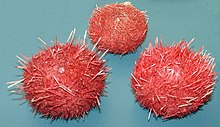Sterechinus
| Sterechinus | |
|---|---|

| |
| Sterechinus neumayeri | |
| Scientific classification | |
| Domain: | Eukaryota |
| Kingdom: | Animalia |
| Phylum: | Echinodermata |
| Class: | Echinoidea |
| Order: | Camarodonta |
| Family: | Echinidae |
| Genus: | Sterechinus Koehler, 1901 [1] |
| Species | |
|
See text | |
Sterechinus is a genus of sea urchins in the family Echinidae. All living members of the genus are found in the waters around Antarctica but the first species described in the genus was a fossil and was found in Europe.
Description[edit]
Members of the genus Sterechinus have compound ambulacral plates that are trigeminate (composed of three elements). These plates have a primary tubercle articulating with a spine on the middle element, a small secondary tubercle in the interambulacral groove on one side of it and 3 pairs of pores on the other. The tube feet are connected to these pores in the living animal and the pore pairs are arranged in a vertical arc. The sutures between the plates are deeply indented. The area of narrow plates around the mouth is small and the buccal notches are shallowly grooved.[2]
Species[edit]
The type species of this genus is Stirechinus scillae which was first described from a fossil by Pierre Desor in 1856. Stirechinus scillae lived from the Late Miocene to the Plio-Pleistocene and further fossils have since been found in France, Sicily and Malta. None of the fossilized urchins so far discovered had any apical plates.[2]
Since then, other members of the genus have been described, all from the waters around Antarctica. The World Register of Marine Species lists the following extant species in the genus:[1]
- Sterechinus agassizii Mortensen, 1910
- Sterechinus antarcticus Koehler, 1901
- Sterechinus bernasconiae Larrain, 1975
- Sterechinus dentifer Koehler, 1926
- Sterechinus diadema (Studer, 1876)
- Sterechinus neumayeri (Meissner, 1900)
References[edit]
- ^ a b Kroh, Andreas (2010). Kroh A, Mooi R (eds.). "Sterechinus Koehler, 1901". World Echinoidea Database. World Register of Marine Species. Retrieved 2012-01-09.
- ^ a b Stirechinus Desor, 1856 The Natural History Museum. Retrieved 2012-01-09.

